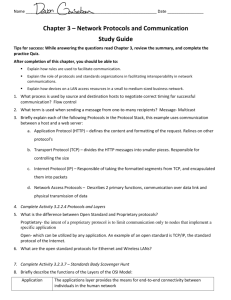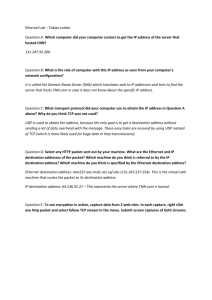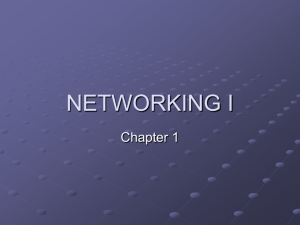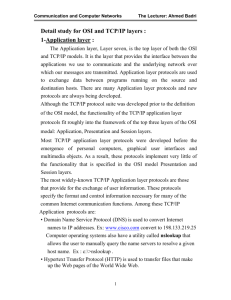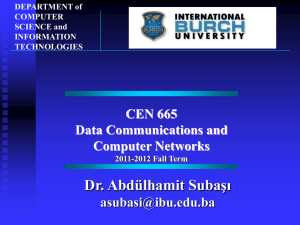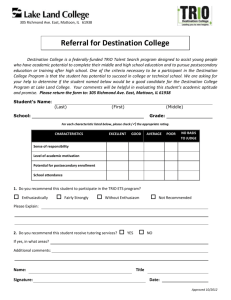Network Protocols & Communication Study Guide
advertisement
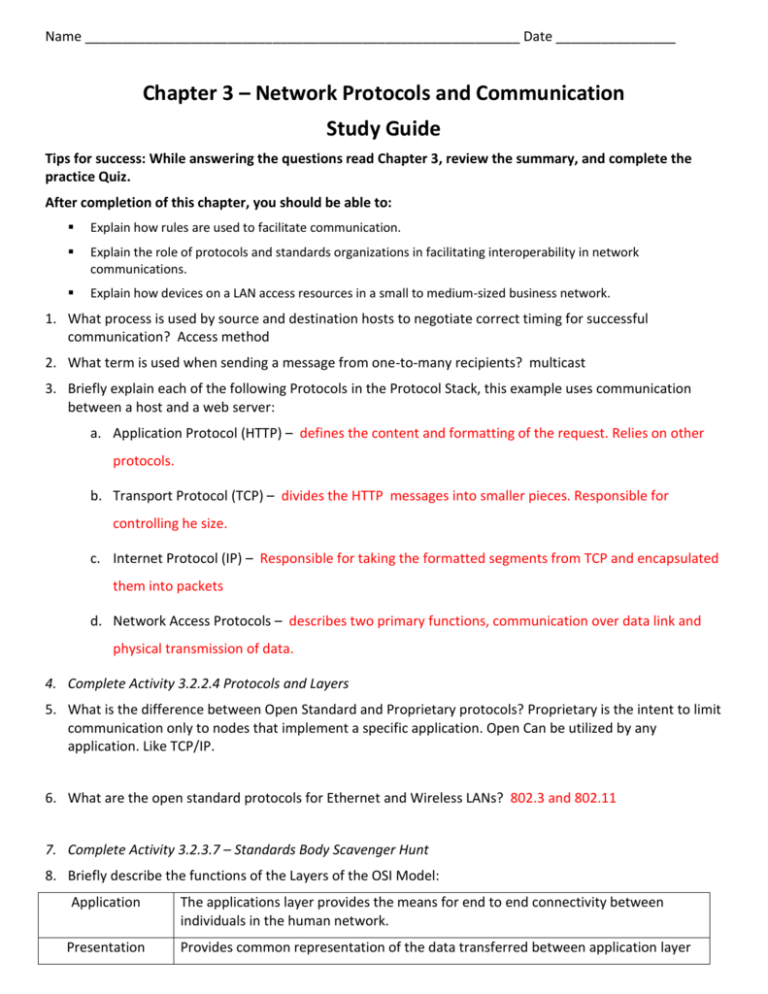
Name __________________________________________________________ Date ________________ Chapter 3 – Network Protocols and Communication Study Guide Tips for success: While answering the questions read Chapter 3, review the summary, and complete the practice Quiz. After completion of this chapter, you should be able to: Explain how rules are used to facilitate communication. Explain the role of protocols and standards organizations in facilitating interoperability in network communications. Explain how devices on a LAN access resources in a small to medium-sized business network. 1. What process is used by source and destination hosts to negotiate correct timing for successful communication? Access method 2. What term is used when sending a message from one-to-many recipients? multicast 3. Briefly explain each of the following Protocols in the Protocol Stack, this example uses communication between a host and a web server: a. Application Protocol (HTTP) – defines the content and formatting of the request. Relies on other protocols. b. Transport Protocol (TCP) – divides the HTTP messages into smaller pieces. Responsible for controlling he size. c. Internet Protocol (IP) – Responsible for taking the formatted segments from TCP and encapsulated them into packets d. Network Access Protocols – describes two primary functions, communication over data link and physical transmission of data. 4. Complete Activity 3.2.2.4 Protocols and Layers 5. What is the difference between Open Standard and Proprietary protocols? Proprietary is the intent to limit communication only to nodes that implement a specific application. Open Can be utilized by any application. Like TCP/IP. 6. What are the open standard protocols for Ethernet and Wireless LANs? 802.3 and 802.11 7. Complete Activity 3.2.3.7 – Standards Body Scavenger Hunt 8. Briefly describe the functions of the Layers of the OSI Model: Application Presentation The applications layer provides the means for end to end connectivity between individuals in the human network. Provides common representation of the data transferred between application layer Session Provides services to the presentation layer to organize its dialog and to manage Transport Defines services into segment transfers and reassembles the data for individual communication between devices Network Provides services to exchange the individual pieces of data over the network Data Link Protocols describe methods for exchanging data frames between devices Physical Describe anything physical electrical 9. Complete Activity 3.2.4.5 – Identify Layers and Functions 10. What is data encapsulation? Each succeeding layer adds the data from the previous layer to its own data and passes it all to the next layer. 11. Fill in the correct protocol data unit (PDU) for each layer: Upper Layers Encode application data Transport Destination and source process numbers Network Destination and source logical network address Data Link Destination and source physical address Physical Timing and synchronization bits 12. What addresses are contained in the Packet Header? Network layer, IP packets 13. What addresses are contained in the Frame Header? Data link Ethernet 14. An ARP Request contains the IP address of the destination device. An ARP Reply includes the MAC address associated with the IP address in the ARP Request. 15. What is the purpose of the Default Gateway?a gateway is a node on a TCP/IP network that servers as an access point to another network 16. When is an Ethernet Frame sent to the Default Gateway? When it connects 17. Answer the following questions based on the diagram below: a. When sending data from PC1 to the Web Server, what is the source and destination IP address? Source: 192.168.1.100 Destination: 172.16.1.99 b. When sending data from PC1 to the Web Server, what is the source and destination MAC address? Source: AA-AA-AA-AA-AA-AA Destination: AB-CD-EF-12-34-56 c. What is the Default Gateway for PC1 and PC2? 25.255.255.0 PC1 Web Server PC2
